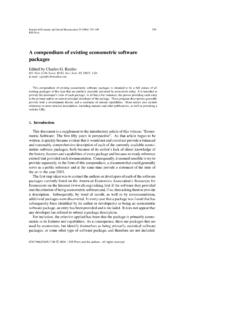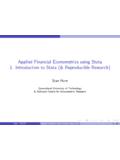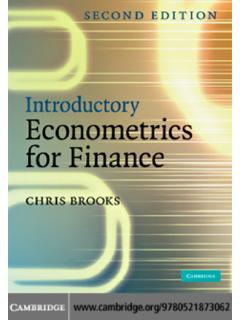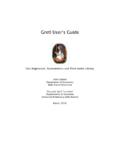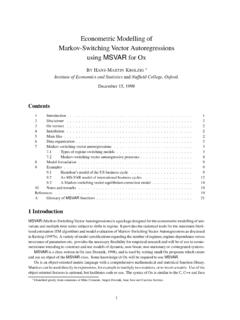Transcription of Determinants of Farmers’ Perception of soil and water
1 Agricultural Science, Engineering and Technology Research Vol. 2, No. 5, November 2014, pp. 1- 9, ISSN: 2333 - 0953 (Online). Available on line at Research article Determinants of Farmers' Perception of soil and water Conservation Practices on Cultivated Land in Ankesha District, Ethiopia Dessalew Meseret Department of Natural Resource Management, Debre Tabor University, Ethiopia Phone +251913451745 Fax: +251584412260. Email: This work is licensed under a Creative Commons Attribution International License. Abstract Soil erosion on cultivated land constitutes a threat to the livelihood of rural households in Ethiopia. Although it is recognized that soil water conservation (SWC) practices can sustainably contribute to reversing land degradation, the performance conservation practices in most Third World countries have generally been unsatisfactory in terms of success and sustained use by smallholder farmers. Past efforts at soil and water conservation did not bring about significant results mainly due to the top-down approach that has gave little attention to the Perception of farmers.
2 Understanding farmers' Perception of soil erosion problem and involving them in decision making to conserve natural resources generally and soil and water particularly will play a great role to ensure sustainable development of one country. This paper examined farmers' Perception of soil and water conservation practices on cultivated land in Ankesha Woreda, Ethiopia. The primary data were collected from 149 sample households selected, from Huletu Chaja and Sostu Gimjabet Kebeles, through systematic random sampling technique. Logistic regression analysis has been employed to separate the major factors influencing farmers' Perception of soil and water conservation practices. The result indicates that percent of the farmers perceived soil erosion on cultivated land can be controlled through different traditional and improved conservation measures. However, nearly half percent of respondents perceived that controlling soil erosion is difficult. Educational level of the household head; land insecurity, extension contact; and slope of the plot, distance of the plot from residence and plot size are the most important Determinants of farmers' Perception of conservation practices.
3 The implication is that taking these factors 1. Agricultural Science, Engineering and Technology Research Vol. 2, No. 5, November 2014, pp. 1- 9, ISSN: 2333 - 0953 (Online). Available on line at into account while planning soil conservation measures will enhance farmers' commitment to soil and water conservation. Copyright ASETR, all rights reserved. Key words: Cultivated Land, Soil Erosion, Conservation Practices, Farmers' Perception , Logistic Regression, 1. Introduction Climate change, in combination with the expanding human population, presents a food security worldwide challenge. Population growth and the dynamics of climate change exacerbates desertification, deforestation, erosion, degradation, and depletion of water resources (Bangizi, 2012). Smallholder farmers in Ethiopia whose livelihoods entirely depend on rain-fed agriculture are highly vulnerable to these problems. The agricultural sector plays a dominant role in Ethiopian economy, contributing to nearly 50 percent of the GDP and provides employment for over 80 percent of the labor force and which accounts for a little over (FAO, 1986).
4 In fact, agriculture in Ethiopia is not only an economic activity but also a way of life for which agricultural land is an indispensable resource upon which the welfare of the society is built. The livelihood of the vast majority of the population depends directly or indirectly on this sector. Needless to mention, such dependence obviously leads to increased land degradation (Gould et al, 1989). FAO (2000) estimated that some 50% of the highlands are significantly eroded, of which 25%. are seriously eroded, and 4% have reached at a point of no return. The area of cropland that constitutes 13% of Ethiopia's land mass is the leading region of soil loss, with an average erosion of 42 ton ha -1. The problems of land degradation and low agricultural productivity, which results in food insecurity and poverty, are particularly severe in the rural highlands of Ethiopia that constitute 95% of the cultivable area in the country and that support 88% of the human and 75% of the livestock population (Holden et al.)
5 , 2005). Farmers' Perception of soil erosion plays a key role in their decision making on land use and management practices. Different farmers may have different attitudes towards soil conservation. Farmers' Perception affect the selection and continued use of soil conservation practices (Bandara, 2008). Sometimes farmers who have good attitudes also may not practice soil conservation at a good level due to other factors influencing their practices. However, agricultural planners and scientists forget that farmers, best understand their own lands and objectives (Taangahar et al, 2011). While national policy and top down agricultural development strategies have their place, these may only be implemented through the active participation of farmers. It is the farmers who mobilize their resources and take risks, to assist their crops overcome soil constraints on productivity. Many farmers are aware of land degradation, but their priorities are food production and income generation during the current or next cropping cycle, rather than in the more distant future (Taangahar et al, 2011).
6 Perception of soil degradation factors and how to prevent them is a necessary condition for farmers' to investment in conservation technologies. Insufficient attention has been given to examining local-level factors, like socioeconomic, institutional, and biophysical, affecting Perception of farmers about their participation in SWC. activities (Stahl, 1990; Million, 1996; and Azene, 1997). According to Amarasekara et al. (2009), and Ulimwengu and Sanyal (2011), willingness to invest in soil conservation measures increases with farm income, level of awareness and ownership security of land. Thus, appropriate understanding of these factors would assist in the formulation and implementation of the policy interventions designed to induce voluntary continued use of SWC. measures. Therefore, the main objective of this study was to investigate the major Determinants of Perception of farmers on soil and water conservation practices on cultivated land in Ankesha District. 2. Materials and Methods Study Area 2.
7 Agricultural Science, Engineering and Technology Research Vol. 2, No. 5, November 2014, pp. 1- 9, ISSN: 2333 - 0953 (Online). Available on line at Figure 1. Location map of the study area, Ethiopia The district is located in the North-Western part of Ethiopian, approximately 480 km north-west of Addis Ababa, the capital city and 140 km south-west of Bahir Dar, capital of the region. Geographically its absolute location extends between the coordinates of 10 31'46'' and 10 41'32'' North latitude and 36 36'18'' and 36 59'33'' East longitude. The total area of the district is estimated to be nearly km2. A triangle-shaped district in the Awi Zone, Ankesha is bordered on the south by Mirab Gojjam, on the west by Guangua, on the north by Banja shekudad and on the east by Guagusa shekudad (see Figure1 below). The district has an elevation varying from 1800 to 2800 masl. The major relief features of the district include mountains, undulating plains, hilly and gullies and valleys. The three dominant soil types of district are nitosol, fluvisols (at gentler slopes and river banks) and vertisols, locally, walhi (covers the major lower slope positions of the area.)
8 Varied topography of the area resulted in diverse climatic 3. Agricultural Science, Engineering and Technology Research Vol. 2, No. 5, November 2014, pp. 1- 9, ISSN: 2333 - 0953 (Online). Available on line at patterns. The resulting weather pattern provides the highlands with most of its rainfall during a period that generally lasts from mid-June to mid-September. The earliest written records and oral sources gave us image of a well- managed and dense vegetation cover in district. But land pressure and deforestation has now resulted in replacement by bush and grassland. A few remnants of the natural vegetation can be found in church compounds, sacred places and along stream banks. Sample size determination Two stage sampling techniques were applied to select the sample households. In the first stage, a purposive sampling method was employed to identify representative kebeles from the district. From the total of 29 rural kebeles, two were selected purposively by considering topography, severity of soil erosion problem, and agro- ecology.
9 Next, lists of households in each kebele were obtained from the respective offices of development agents. With the lists, a systematic random sampling procedure was used to select a total of 149 sample households. Data collection The major source of data was a formal household survey. A structured questionnaire was used for the field interviews. The questionnaire, with close and open ended type, was pre-tested by administering it to selected respondents. On the basis of the results obtained from the pre-test, necessary modifications were made on the questionnaire. On-site discussion with individual farmers and field observation were also other methods of data collection. Data analysis The study employed both descriptive statistics and econometric methods to analyze the data collected from the sample respondents. To run statistical analysis, data were coded and entered in to a computer program known as statistical package for social studies (SPSS) version 15 software packages. Empirical Model and Identification of Variables Logistic regression is a widely applied statistical tool to study farmers' Perception conservation technologies (Shiferaw, 1998; Neupane et al.)
10 , 2002). Logistic regression allows predicting a discrete outcome from a set of variables that may be continuous, discrete, and dichotomous or a combination of them. The dependent variable, ( , Perception of soil and water conservation practices) is dichotomous discrete variable that is generated from the questionnaire survey as a binary response, and the independent variables are a mixture of discrete and continuous. Following the methods of used by Abera (2003) and Mekuria (2005), the logistic regression model characterizing Perception of the sample households is specified as: Pi = F ( + Xi) = 1. -( + Xi). 1+e th Where i denotes the i observation in the sample; Pi is the probability that an individual will make a certain choice given Xi; e is the base of natural logarithms and approximately equal to ; Xi is a vector of exogenous; variables 4. Agricultural Science, Engineering and Technology Research Vol. 2, No. 5, November 2014, pp. 1- 9, ISSN: 2333 - 0953 (Online). Available on line at and are parameters of the model, 1, 2 , k are the coefficients associated with each explanatory variables X1, X2, , Xn.
